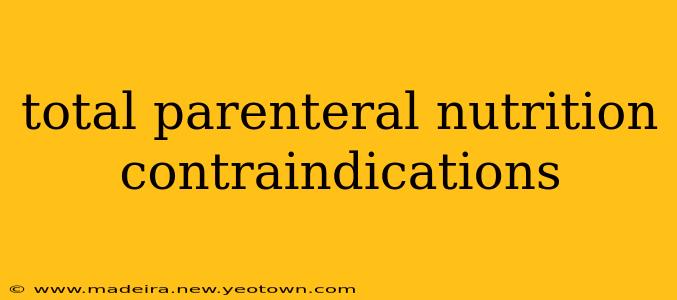Total Parenteral Nutrition (TPN) is a lifeline for individuals unable to receive adequate nutrition through the digestive tract. It delivers essential nutrients directly into the bloodstream, bypassing the gut entirely. While a powerful tool, TPN isn't a universal solution, and certain situations make it contraindicated – meaning it shouldn't be used. This article explores those contraindications, shedding light on why TPN might be unsuitable in specific cases, and highlighting alternative approaches.
Imagine Sarah, a patient recovering from major abdominal surgery. Her intestines are inflamed and unable to process food. TPN, in her case, might be a temporary lifesaver, providing the nutrients her body needs while her gut heals. But what about individuals whose bodies might react negatively to TPN itself? That's where understanding contraindications becomes crucial.
What are the Contraindications for TPN?
Several factors can make TPN inappropriate or risky. These contraindications fall into broad categories:
1. Gastrointestinal Tract Functionality:
Can TPN be used if a patient has a functioning GI tract? This is a key question, and the answer is generally no. TPN is reserved for patients whose gastrointestinal tract is unable to absorb sufficient nutrients. If the gut can function, even partially, enteral nutrition (feeding through a tube directly into the stomach or small intestine) is preferred. Enteral feeding is generally safer and better mimics the natural digestive process.
2. Vascular Access Issues:
What are the risks associated with central venous catheters in TPN? TPN requires a central venous catheter – a line inserted into a large vein, typically in the neck or chest. These catheters carry risks, including infection (catheter-related bloodstream infection or CRBSI), thrombosis (blood clot formation), and pneumothorax (collapsed lung). Individuals with compromised vascular access, clotting disorders, or increased risk of infection might be poor candidates for TPN. The decision to use TPN must carefully weigh the benefits against these risks.
3. Metabolic Disturbances:
What metabolic complications can arise with TPN? TPN can disrupt metabolic balance, potentially leading to hyperglycemia (high blood sugar), electrolyte imbalances, and liver dysfunction. Patients with pre-existing metabolic conditions like diabetes or liver disease might be at greater risk for these complications and therefore unsuitable for TPN. Careful monitoring and adjustment of the TPN formula are vital but not always sufficient to prevent complications in certain patients.
4. Sepsis and Immunosuppression:
Is TPN contraindicated in patients with sepsis or a weakened immune system? Yes, patients suffering from sepsis (a life-threatening response to infection) or with significantly weakened immune systems are at heightened risk of serious complications from TPN, especially catheter-related infections. The additional stress of TPN on the already compromised immune system could be devastating.
5. Technical Difficulties:
What are the practical challenges in administering TPN? TPN solutions require specialized preparation and meticulous handling to avoid contamination. Access to trained personnel and appropriate equipment is crucial. Hospitals and clinics without the necessary infrastructure or expertise should not attempt to administer TPN.
Alternative Nutritional Support
When TPN is contraindicated, other methods of nutritional support become necessary. Enteral nutrition, as mentioned, is often the preferred alternative for patients with a partially functioning gastrointestinal tract. Other options might include specialized diets tailored to individual needs or medications to improve nutrient absorption.
Conclusion: A Personalized Approach
The decision of whether or not to use TPN requires careful consideration of the patient's overall health status, the potential benefits, and the inherent risks. It's not a one-size-fits-all approach and should only be implemented by experienced medical professionals who can closely monitor the patient's response and adjust the treatment plan accordingly. Remember, the goal is always to provide the safest and most effective nutrition strategy for the individual.

